A Novel Method for SAR Ship Detection Based on Eigensubspace Projection
Abstract
:1. Introduction
2. Materials and Methods
2.1. Experimental Data
2.2. CFAR Method
2.3. RPCA Method
2.4. The Proposed Method
2.4.1. Phase Space Matrix Construction
2.4.2. Eigenvalue Decomposition
2.4.3. Image Reconstruction
3. Results
3.1. Evaluation Indicators
3.2. Experimental Results
4. Discussion
5. Conclusions
Author Contributions
Funding
Data Availability Statement
Acknowledgments
Conflicts of Interest
References
- Eldhuset, K. An Automatic Ship and Ship Wake Detection System for Spaceborne SAR Images in Coastal Regions. IEEE Trans. Geosci. Remote Sens. 1996, 34, 1010–1019. [Google Scholar] [CrossRef]
- Jie, L.; Ji, W.; Bo, S.; Zhu, S.; Luo, W. Research on Ground Based Microwave Signature Measurement Technology for Spaceborne SAR Applications. In Proceedings of the IEEE International Geoscience and Remote Sensing Symposium, Toronto, ON, Canada, 24–28 June 2002; Volume 5, pp. 2663–2665. [Google Scholar] [CrossRef]
- Yang, R.; Wang, G.; Pan, Z.; Lu, H.; Zhang, H.; Jia, X. A Novel False Alarm Suppression Method for CNN-Based SAR Ship Detector. IEEE Geosci. Remote Sens. Lett. 2021, 18, 1401–1405. [Google Scholar] [CrossRef]
- Du, L.; Wang, Z.; Wang, Y.; Wei, D.; Li, L. Survey of Research Progress on Target Detection and Discrimination of Single-channel SAR Images for Complex Scenes. J. Radars 2020, 9, 34–54. [Google Scholar] [CrossRef]
- Greenspan, M.; Pham, L.; Tardella, N. Development and Evaluation of a Real Time SAR ATR System. In Proceedings of the IEEE National Conference on Radar, Dallas, TX, USA, 14 May 1998; pp. 38–43. [Google Scholar] [CrossRef]
- Chong, J.; Zhu, M. Survey of the Study on Ship and Wake Detection in SAR Imagery. Acta Electron. Sin. 2003, 31, 1356–1360. [Google Scholar]
- Li, J.; Tian, J.; Gao, P.; Li, L. Ship Detection and Fine-Grained Recognition in Large-Format Remote Sensing Images Based on Convolutional Neural Network. In Proceedings of the IEEE International Symposium on Geoscience and Remote Sensing (IGARSS), Waikoloa, HI, USA, 26 September–2 October 2020; pp. 2859–2862. [Google Scholar] [CrossRef]
- Yu, W.; Wang, Y.; Liu, H.; He, J. Superpixel-Based CFAR Target Detection for High-Resolution SAR Images. IEEE Geosci. Remote Sens. Lett. 2016, 13, 730–734. [Google Scholar] [CrossRef]
- Ai, J.; Cao, Z.; Mao, Y.; Wang, H.; Wang, F.; Jin, J. An Improved Bilateral CFAR Ship Detection Algorithm for SAR Image in Complex Environment. J. Radars 2021, 10, 499–515. [Google Scholar] [CrossRef]
- Li, C.; Yu, Z.; Chen, J. Overview of Techniques for Improving High-resolution Spaceborne SAR Imaging and Image Quality. J. Radars 2019, 8, 717–731. [Google Scholar] [CrossRef]
- Ai, J.; Cao, Z.; Xing, M. An Adaptive-trimming-depth Based CFAR Detector of Heterogeneous Environment in SAR Imagery. Remote Sens. Lett. 2020, 11, 730–738. [Google Scholar] [CrossRef]
- Markopoulos, P.; Dhanaraj, M.; Savakis, A. Adaptive L1-Norm Principal-Component Analysis with Online Outlier Rejection. IEEE J. Sel. Top. Signal Process. 2018, 12, 1131–1143. [Google Scholar] [CrossRef]
- Javed, S.; Mahmood, A.; Al-Maadeed, S.; Bouwmans, T.; Ki Jung, S. Moving Object Detection in Complex Scene Using Spatiotemporal Structured-Sparse RPCA. IEEE Trans. Image Process. 2018, 28, 1007–1022. [Google Scholar] [CrossRef]
- Biondi, F. Low-Rank Plus Sparse Decomposition and Localized Radon Transform for Ship-Wake Detection in Synthetic Aperture Radar Images. IEEE Geosci. Remote Sens. Lett. 2018, 15, 117–121. [Google Scholar] [CrossRef]
- Liu, T.; Yang, Z.; Jiang, Y.; Gao, G. Review of Ship Detection in Polarimetric Synthetic Aperture Imagery. J. Radars 2021, 10, 1–19. [Google Scholar] [CrossRef]
- Zou, B.; Qiu, Y.; Zhang, L. Ship Detection Using PolSAR Images Based on Simulated Annealing by Fuzzy Matching. IEEE Geosci. Remote Sens. Lett. 2022, 19, 1–5. [Google Scholar] [CrossRef]
- Xi, Y.; Zhang, X.; Lai, Q.; Li, W.; Lang, H. A New PolSAR Ship Detection Metric Fused by Polarimetric Similarity and the Third Eigenvalue of the Coherency Matrix. In Proceedings of the IEEE International Geoscience and Remote Sensing Symposium, Beijing, China, 10–15 July 2016; pp. 112–115. [Google Scholar] [CrossRef]
- Liu, T.; Yang, Z.; Yang, J.; Gao, G. CFAR Ship Detection Methods Using Compact Polarimetric SAR in a K-Wishart Distribution. IEEE J. Sel. Top. Appl. Earth Obs. Remote Sens. 2019, 12, 3737–3745. [Google Scholar] [CrossRef]
- Fan, Q.; Chen, F.; Cheng, M.; Wang, C.; Li, J. A Modified Framework for Ship Detection from Compact Polarization SAR Image. In Proceedings of the IEEE International Geoscience and Remote Sensing Symposium, Valencia, Spain, 22–27 July 2018; pp. 3539–3542. [Google Scholar] [CrossRef]
- Novak, L.M.; Owirka, G.J.; Netishen, C.M. Performance of a High-Resolution Polarimetric SAR Automatic Target Recognition System. Linc. Lab. J. 1992, 6, 11–23. [Google Scholar]
- Li, C.; Xu, H.; Qian, K.; Deng, B.; Feng, Z. Survey of Ship Detection Technology Based on Deep Learning. J. Ordnance Equip. Eng. 2021, 42, 57–63. [Google Scholar] [CrossRef]
- Kang, M.; Ji, K.; Leng, X.; Lin, Z. Contextual Region-Based Convolutional Neural Network with Multilayer Fusion for SAR Ship Detection. Remote Sens. 2017, 9, 860. [Google Scholar] [CrossRef] [Green Version]
- Ma, M.; Chen, J.; Liu, W.; Yang, W. Ship Classification and Detection Based on CNN Using GF-3 SAR Images. Remote Sens. 2018, 10, 2043. [Google Scholar] [CrossRef] [Green Version]
- Chen, C.; He, C.; Hu, C.; Pei, H.; Jiao, L. A Deep Neural Network Based on an Attention Mechanism for SAR Ship Detection in Multiscale and Complex Scenarios. IEEE Access 2019, 7, 104848–104863. [Google Scholar] [CrossRef]
- Wu, D.; Du, X.; Wang, K. An Effective Approach for Underwater Sonar Image Denoising Based on Sparse Representation. In Proceedings of the IEEE International Conference on Image, Vision and Computing (ICIVC), Chongqing, China, 27–29 June 2018; pp. 389–393. [Google Scholar] [CrossRef]
- Soganli, A.; Cetin, M. Sparsity-driven SAR Image Reconstruction via Low-rank Sparse Matrix Decomposition. In Proceedings of the Signal Processing and Communications Applications Conference, Malatya, Turkey, 16–19 May 2015; pp. 2333–2336. [Google Scholar] [CrossRef]
- Zhang, S.; Zhang, Y.; Chou, Y.; Wang, Z.; Shi, Y.; Sun, Z. Analysis of the Multispectral and SAR Image. In Proceedings of the IEEE International Conference on Computer and Communication Systems (ICCCS), Chengdu, China, 23–26 April 2021; pp. 312–315. [Google Scholar] [CrossRef]
- Zhang, G.; Li, Z.; Li, X.; Yin, C.; Shi, Z. A Novel Salient Feature Fusion Method for Ship Detection in Synthetic Aperture Radar Images. IEEE Access 2020, 8, 215904–215914. [Google Scholar] [CrossRef]
- Zhao, Y.; Zhao, L.; Xiong, B. Kuang, G. Attention Receptive Pyramid Network for Ship Detection in SAR Images. IEEE J. Sel. Top. Appl. Earth Obs. Remote Sens. 2020, 13, 2738–2756. [Google Scholar] [CrossRef]
- Zhang, S.; Wu, R.; Xu, K.; Wang, J.; Sun, W. R-CNN-Based Ship Detection from High Resolution Remote Sensing Imagery. Remote Sens. 2019, 11, 631. [Google Scholar] [CrossRef] [Green Version]
- Miao, A.D.; Farina, A.; Foglia, G. Knowledge-Based Recursive Least Squares Techniques for Heterogeneous Clutter Suppression. IET Radar Sonar Navig. 2007, 1, 106–115. [Google Scholar] [CrossRef] [Green Version]
- Zhao, J.; Wen, B.; Tian, Y.; Tian, Z.; Wang, S. Sea Clutter Suppression for Shipborne HF Radar Using Cross-Loop/Monopole Array. IEEE Geosci. Remote Sens. Lett. 2019, 16, 879–883. [Google Scholar] [CrossRef]
- Yang, Y.; Xiao, S.; Wang, X. Radar Detection of Small Target in Sea Clutter Using Orthogonal Projection. IEEE Geosci. Remote Sens. Lett. 2019, 16, 382–386. [Google Scholar] [CrossRef]
- Zhou, F.; Xing, M.; Bao, Z. Narrow Band Interference Suppression for SAR Using Eigen-Subspace Based Filtering. J. Electron. Inf. Technol. 2005, 27, 767–770. [Google Scholar]
- Zhang, T.; Zhang, X.; Li, J.; Xu, X.; Wang, B.; Zhan, X.; Xu, Y.; Ke, X.; Zeng, T.; Su, H.; et al. SAR Ship Detection Dataset (SSDD): Official Release and Comprehensive Data Analysis. Remote Sens. 2021, 13, 3690. [Google Scholar] [CrossRef]
- Huang, L.; Liu, B.; Li, B.; Guo, W.; Yu, W.; Zhang, Z.; Yu, W. OpenSARShip: A Dataset Dedicated to Sentinel-1 Ship Interpretation. IEEE J. Sel. Top. Appl. Earth Obs. Remote Sens. 2018, 11, 195–208. [Google Scholar] [CrossRef]
- Sun, X.; Wang, Z.; Sun, Y.; Diao, W.; Zhang, Y.; Fu, K. AIR-SARShip-1.0: High-resolution SAR ship detection dataset. J. Radars 2019, 8, 852–862. [Google Scholar] [CrossRef]
- Tao, D.; Normann Anfinsen, S.; Brekke, C. Robust CFAR Detector Based on Truncated Statistics in Multiple-Target Situations. IEEE Geosci. Remote Sens. Lett. 2015, 54, 117–134. [Google Scholar] [CrossRef]
- Pappas, O.; Achim, A.; Bull, D. Superpixel-Level CFAR Detectors for Ship Detection in SAR Imagery. IEEE Geosci. Remote Sens. Lett. 2018, 15, 1397–1401. [Google Scholar] [CrossRef] [Green Version]
- Vaswani, N.; Bouwmans, T.; Javed, S.; Narayanamurthy, P. Robust Subspace Learning: Robust PCA, Robust Subspace Tracking, and Robust Subspace Recovery. IEEE Signal Process. Mag. 2018, 35, 32–55. [Google Scholar] [CrossRef] [Green Version]
- Candes, E.J.; Li, X.; Ma, Y.; Wright, J. Robust Principal Component Analysis. J. ACM 2011, 58, 1–37. [Google Scholar] [CrossRef]
- Eckstein, J.; Bertsekas, D. On the Douglas-Rachford Splitting Method and the Proximal Point Algorithm for Maximal Monotone Operators. Math. Program. 1992, 55, 293–318. [Google Scholar] [CrossRef] [Green Version]
- Qiu, W.; Zhou, J.; Fu, Q. Jointly Using Low-Rank and Sparsity Priors for Sparse Inverse Synthetic Aperture Radar Imaging. IEEE Trans. Image Process. 2020, 29, 100–115. [Google Scholar] [CrossRef]
- Shi, G.; Huang, T.; Dong, W.; Wu, J.; Xie, X. Robust Foreground Estimation via Structured Gaussian Scale Mixture Modeling. IEEE Trans. Image Process. 2018, 27, 4810–4824. [Google Scholar] [CrossRef]
- Zheng, L.; Yao, W.; Yang, C.; Qiu, H. Clutter Suppression Method for Short Range Slow Moving Target Detection. J. Electron. Inf. Technol. 2018, 40, 2506–2512. [Google Scholar] [CrossRef]
- Nguyen, L.H.; Ton, T.; Wong, D.; Soumekh, M. Adaptive Coherent Suppression of Multiple Wide-bandwidth RFI Sources in SAR. In Proceedings of the SPIE—The International Society for Optical Engineering, Orlando, FL, USA, 2 September 2004; Volume 5427, pp. 1–16. [Google Scholar] [CrossRef]
- Yang, J.; Kavehm, M. Adaptive eigensubspace algorithms for direction or frequency estimation and tracking. IEEE Trans. Acoust. 1988, 36, 241–251. [Google Scholar] [CrossRef]
- Sun, Y.; Zhang, B.; Wang, C.; Wu, F. Ship detection Based on Eigenvalue-eigenvector Decomposition and OS-CFAR Detector. In Proceedings of the International Conference on Computer Vision in Remote Sensing, Xiamen, China, 16–18 December 2012; pp. 350–355. [Google Scholar] [CrossRef]
- Santhanam, A.; Rahman, M. Moving Vehicle Classification Using Eigenspace. In Proceedings of the IEEE/RSJ International Conference on Intelligent Robots and Systems, Beijing, China, 5–9 October 2006; pp. 3849–3854. [Google Scholar] [CrossRef]
- Wu, J.; Cao, X.; Chen, Y.; Sun, J. Tow Ship Interference Suppression for Towed Array Sonar via Subspace Reconstruction. In Proceedings of the International Conference on Wireless Communications and Signal Processing (WCSP), Hangzhou, China 18–20 October 2018; pp. 1–7. [Google Scholar] [CrossRef]
- Liu, G.; Zhang, X.; Meng, J. A Small Ship Target Detection Method Based on Polarimetric SAR. Remote Sens. 2019, 11, 2938. [Google Scholar] [CrossRef] [Green Version]

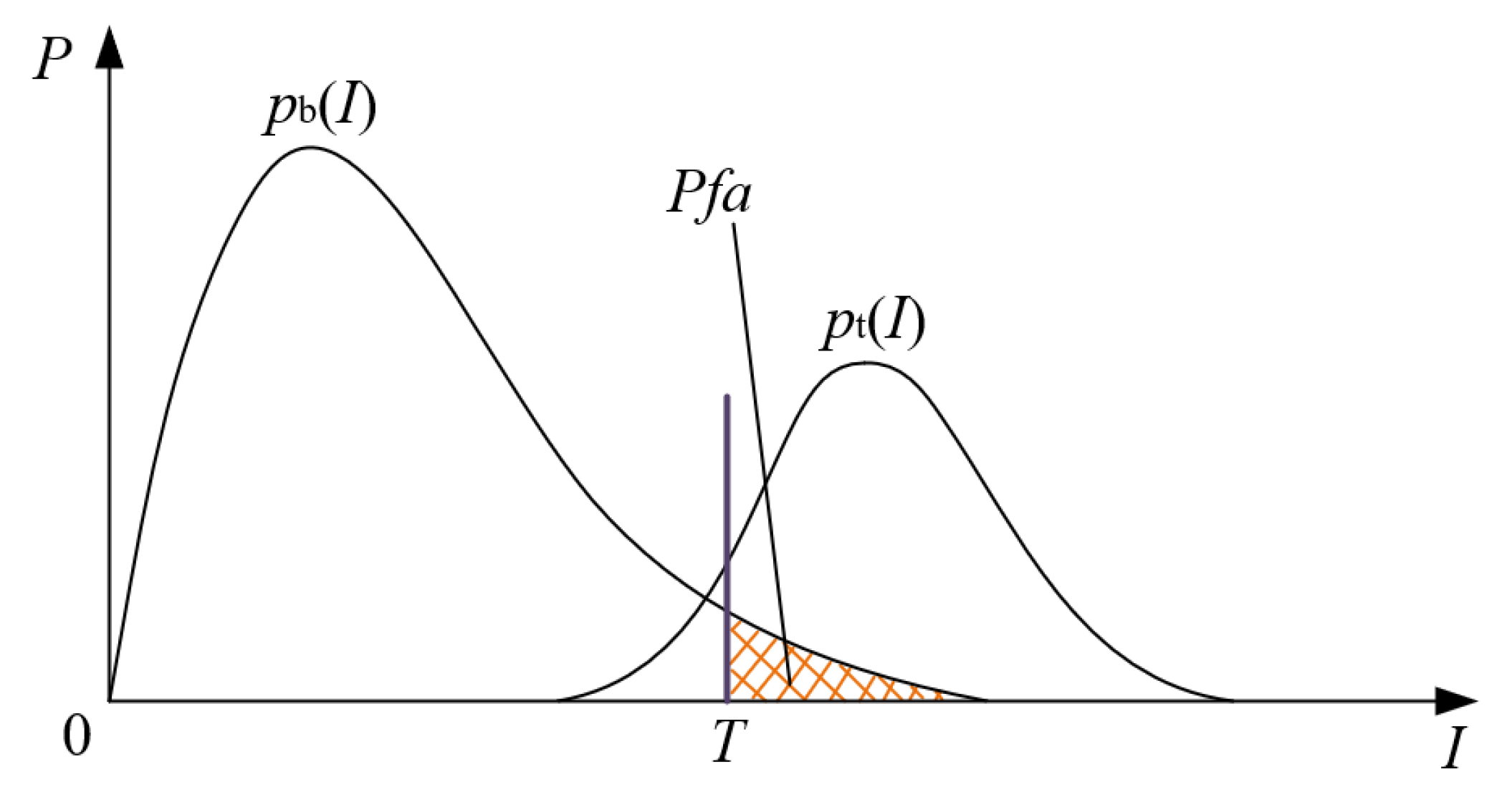
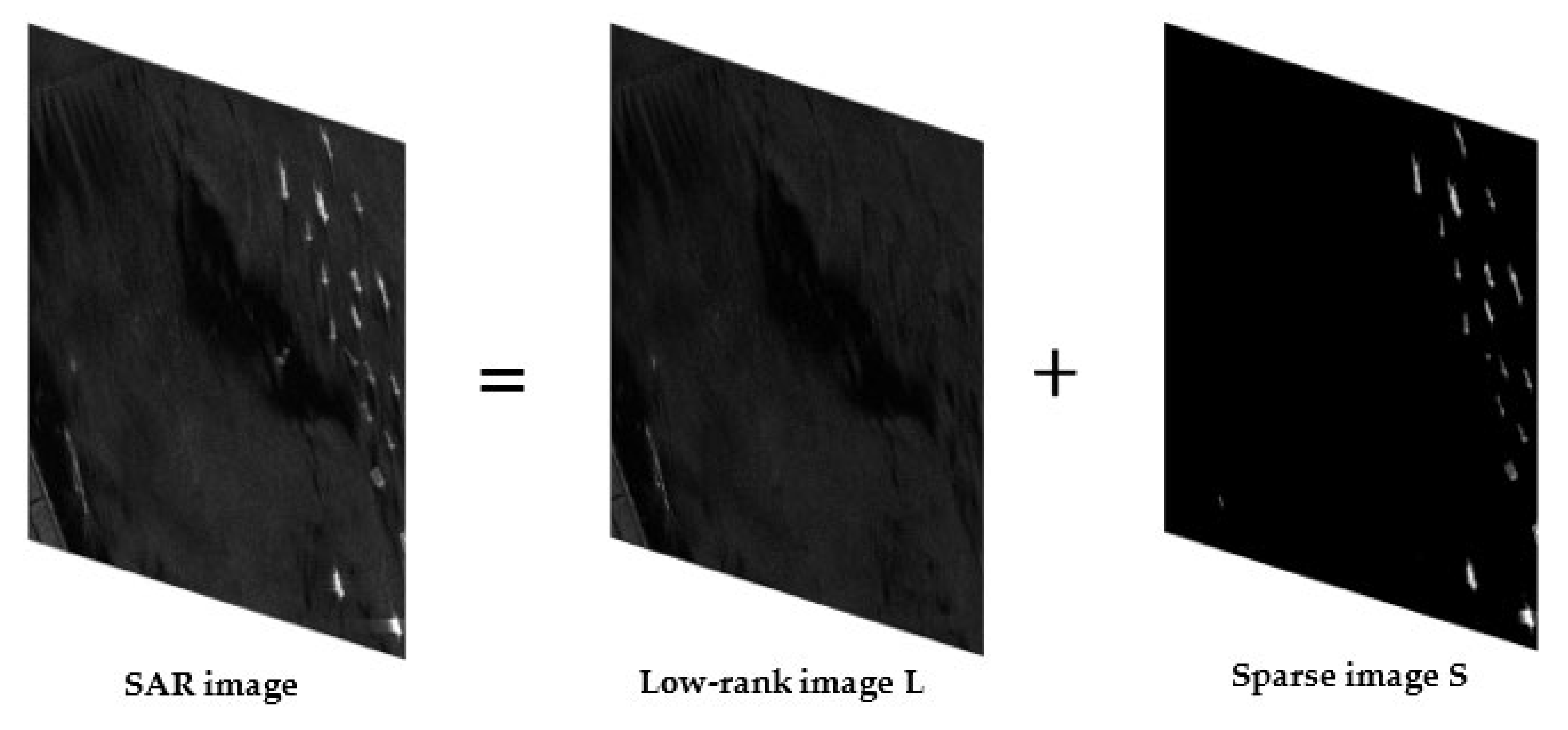
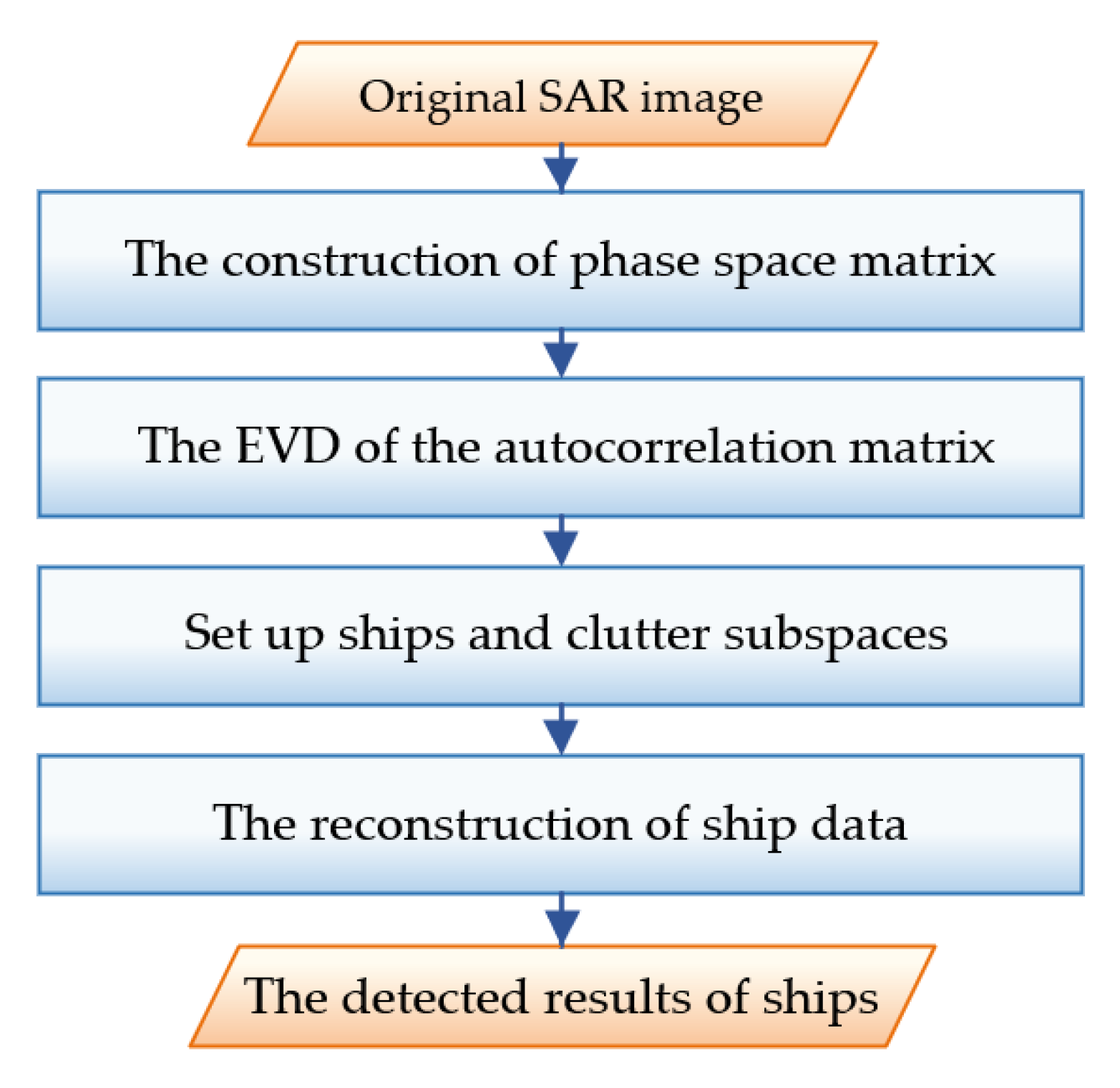

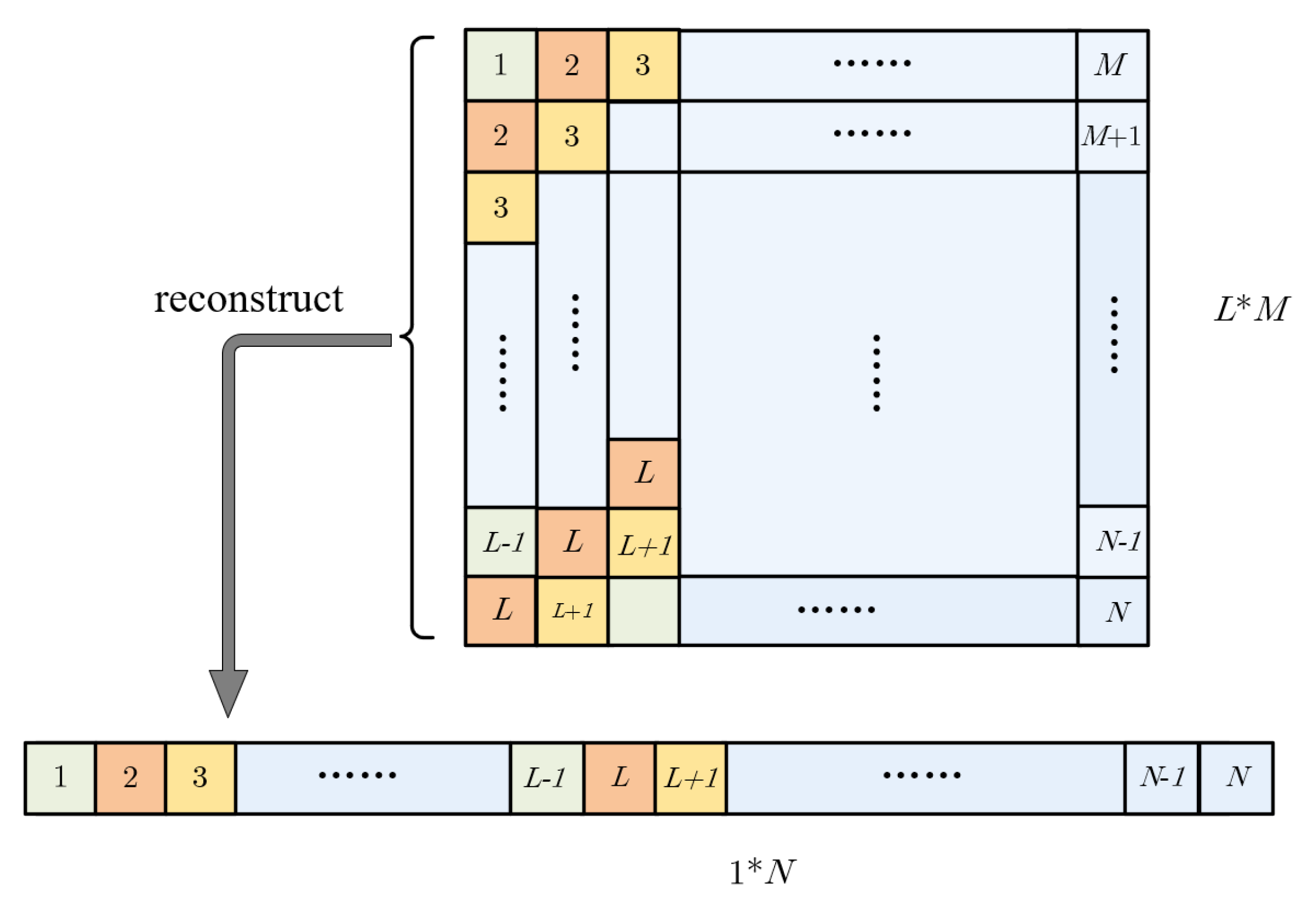
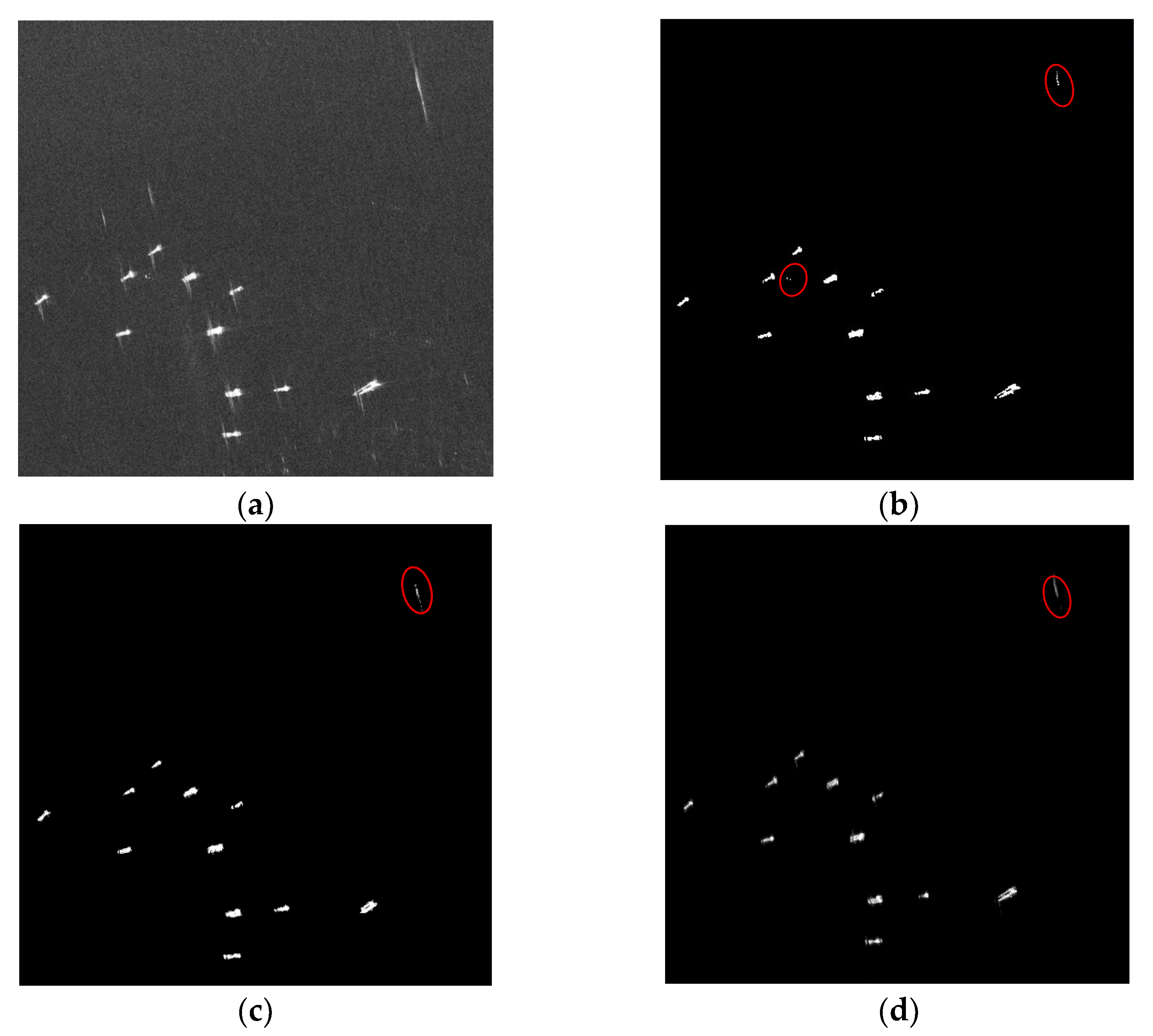
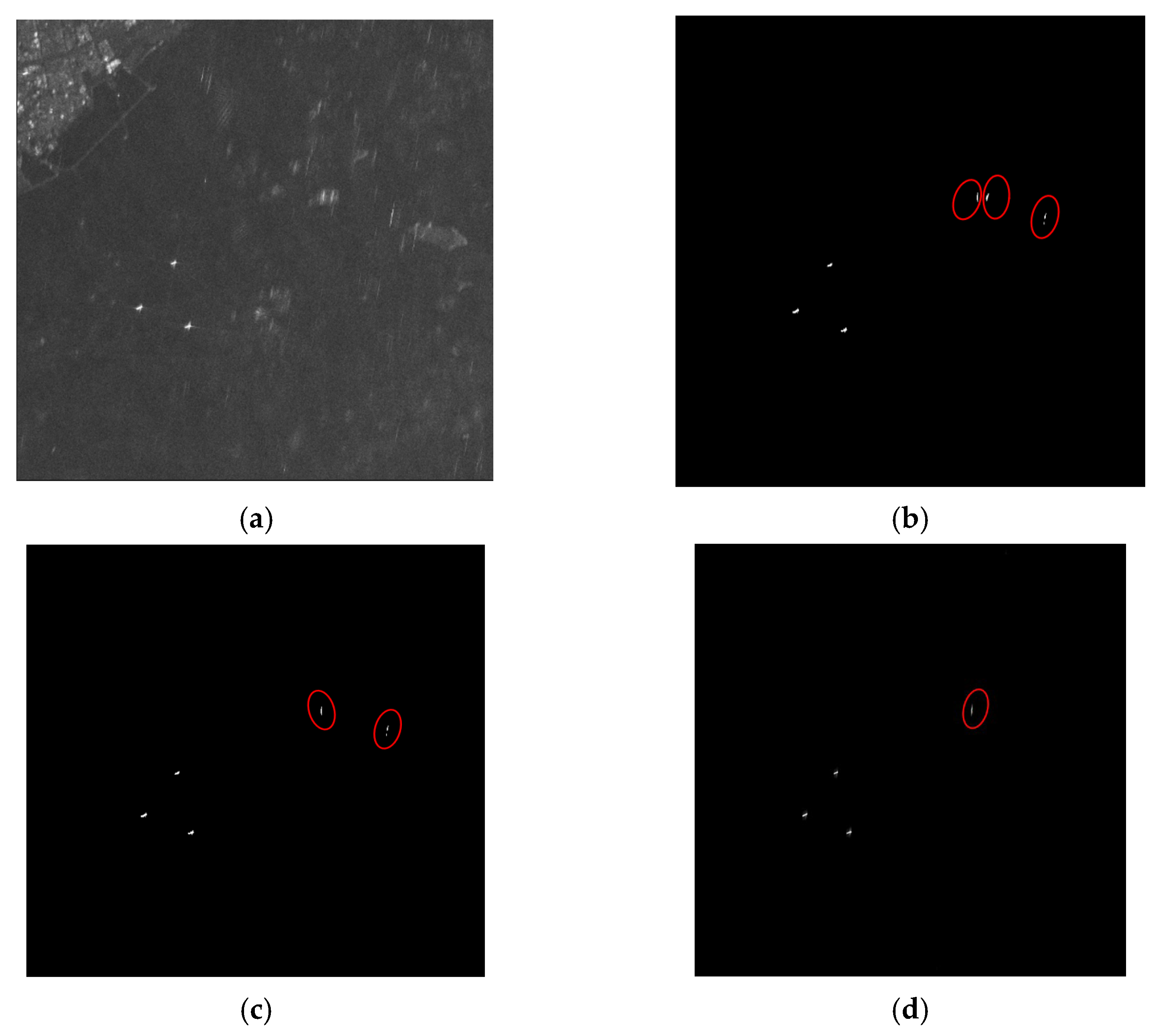

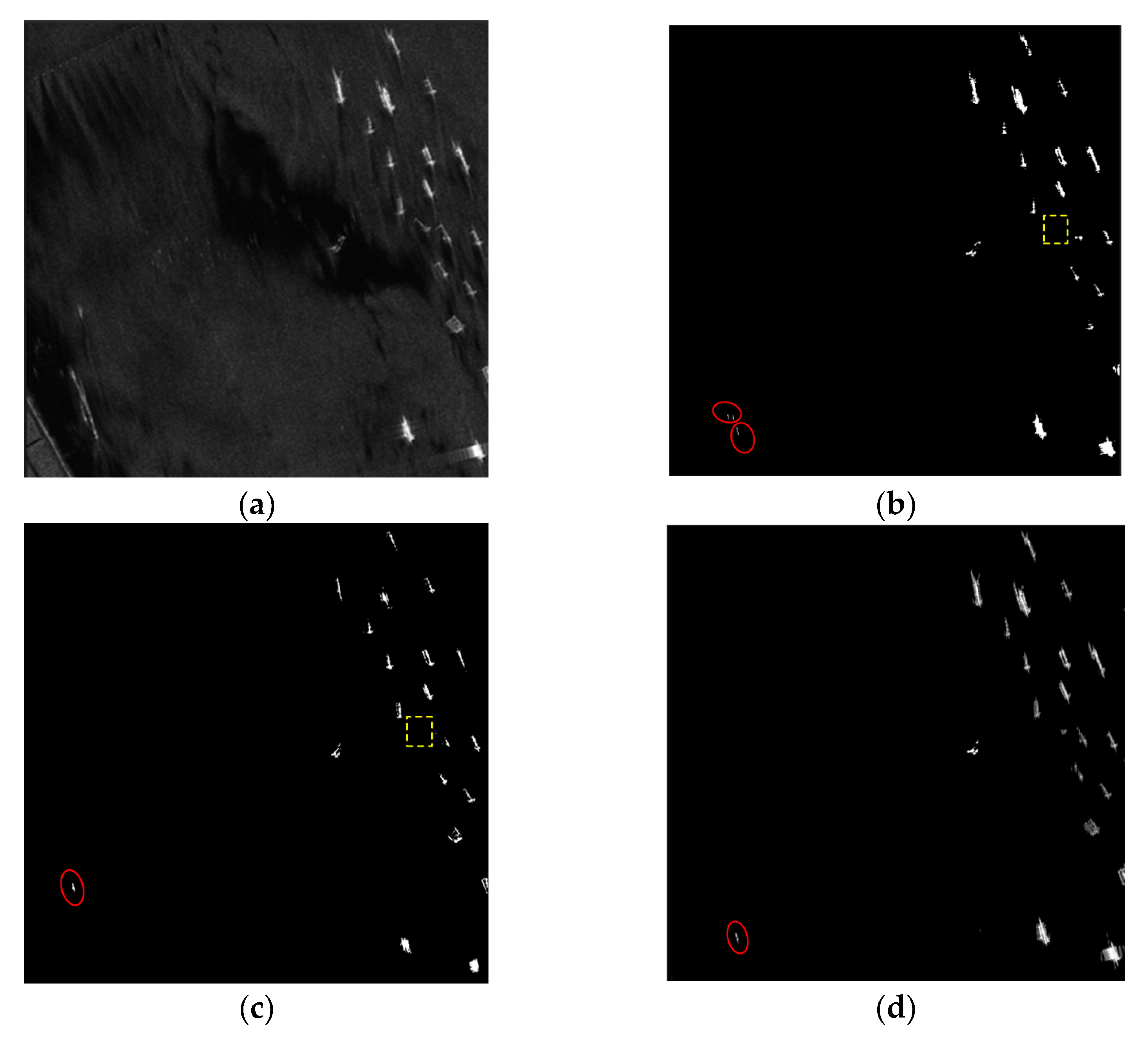
| Imaging Mode | Incident Angle (°) | Resolution (m) | Polarization Mode |
|---|---|---|---|
| Spotlight | 20–50 | 1 | Single polarization |
| Strip-map | 20–50 | 3 | Single polarization |
| Scene | Sea State | Number of Images |
|---|---|---|
| Nearshore | 0 | 1 |
| 1 | 9 | |
| 2 | 7 | |
| 3 | 4 | |
| Offshore | 1 | 2 |
| 2 | 2 | |
| 3 | 2 | |
| 4 | 4 |
| Image | Method | FoM (%) | MR (%) | FR (%) | ||||
|---|---|---|---|---|---|---|---|---|
| 1 | RPCA | 11 | 11 | 0 | 2 | 84.62 | 0 | 18.18 |
| SP-CFAR | 11 | 0 | 1 | 91.67 | 0 | 9.09 | ||
| ESSP | 11 | 0 | 1 | 91.67 | 0 | 9.09 | ||
| 2 | RPCA | 3 | 3 | 0 | 3 | 50.00 | 0 | 100 |
| SP-CFAR | 3 | 0 | 2 | 60.00 | 0 | 66.67 | ||
| ESSP | 3 | 0 | 1 | 75.00 | 0 | 33.33 | ||
| 3 | RPCA | 42 | 40 | 2 | 3 | 88.89 | 4.76 | 7.14 |
| SP-CFAR | 41 | 1 | 2 | 93.18 | 2.38 | 4.16 | ||
| ESSP | 41 | 1 | 0 | 97.61 | 2.38 | 0 | ||
| 4 | RPCA | 20 | 19 | 1 | 2 | 86.36 | 5.00 | 10.00 |
| SP-CFAR | 19 | 1 | 1 | 90.48 | 5.00 | 10.00 | ||
| ESSP | 20 | 0 | 1 | 95.23 | 0 | 5.00 |
| Method | FoM (%) | MR (%) | FR (%) | Time (s) |
|---|---|---|---|---|
| RPCA | 77.47 | 2.44 | 33.83 | 84.35 |
| SP-CFAR | 83.83 | 1.85 | 21.23 | 198.24 |
| ESSP | 89.87 | 0.59 | 11.86 | 21.37 |
Publisher’s Note: MDPI stays neutral with regard to jurisdictional claims in published maps and institutional affiliations. |
© 2022 by the authors. Licensee MDPI, Basel, Switzerland. This article is an open access article distributed under the terms and conditions of the Creative Commons Attribution (CC BY) license (https://creativecommons.org/licenses/by/4.0/).
Share and Cite
Shu, G.; Chang, J.; Lu, J.; Wang, Q.; Li, N. A Novel Method for SAR Ship Detection Based on Eigensubspace Projection. Remote Sens. 2022, 14, 3441. https://doi.org/10.3390/rs14143441
Shu G, Chang J, Lu J, Wang Q, Li N. A Novel Method for SAR Ship Detection Based on Eigensubspace Projection. Remote Sensing. 2022; 14(14):3441. https://doi.org/10.3390/rs14143441
Chicago/Turabian StyleShu, Gaofeng, Jiahui Chang, Jing Lu, Qing Wang, and Ning Li. 2022. "A Novel Method for SAR Ship Detection Based on Eigensubspace Projection" Remote Sensing 14, no. 14: 3441. https://doi.org/10.3390/rs14143441






